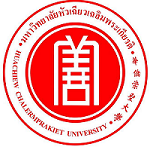Please use this identifier to cite or link to this item:
https://has.hcu.ac.th/jspui/handle/123456789/2710| Title: | “燕行录”俗字研究及其应用 |
| Other Titles: | การศึกษาอักษรจีนรูปแบบที่ใช้ทั่วไปใน “เยี่ยนสิงลู่” และการประยุกต์ใช้ Research and Application of the Vulgar Characters in "Yonhaengnok". |
| Authors: | 肖瑜 Xiao Yu 李荣 Li Rong Huachiew Chalermprakiet University. College of Chinese Studies |
| Keywords: | ภาษาจีน -- การศึกษาและการสอน Chinese language -- Study and teaching ตัวอักษรจีน Chinese characters การศึกษาข้ามวัฒนธรรม Cross-cultural studies ภูมิรัฐศาสตร์ Geopolitics ความสัมพันธ์ทางวัฒนธรรม Cultural relations ความสัมพันธ์ระหว่างประเทศ International relations 汉语 -- 学习和教学 汉字 跨文化教育 文化关系 国际关 地缘政治 |
| Issue Date: | 2023 |
| Publisher: | Huachiew Chalermprakiet University |
| Abstract: | “Yonhaengnok” is an important collection of extraterritorial Chinese documents that has gained significant attention from China, South Korea, and other neighboring countries in recent years. It contains valuable literary, historical, religious, and economic materials. The compiled “Yonhaengnok” covers a time span from the early 12th century to the late 19th century, encompassing records written by envoys and related individuals from the Korean Peninsula's Goryeo and Joseon dynasties during their visits to China, including various types of poems and writings, such as engraved copies, transcriptions, and printed editions. Spanning over seven centuries, the “Yonhaengnok” features a substantial number of vulgar characters and has formed certain patterns of evolution, which play a positive role in studying the dissemination and evolution of Chinese characters beyond their original domain. This article explores the study of vulgar characters in the “Yonhaengnok” in the following aspects:Chapter 1: The emergence of vulgar characters in the “Yonhaengnok” is influenced by specific political and cultural academic backgrounds. Geopolitically and politically, the Korean Peninsula's unique position as being "alone in a corner" has determined its consistent policy of maintaining good relations with various Chinese dynasties such as Jin, Yuan, Ming, and Qing. Consequently, Korean envoys have been visiting "Yan" (China) for over seven centuries, leading to the emergence of distinct terms in the “Yonhaengnok” such as "马头" (Ma Tou) and "獐項" (Zhang Xiang). In terms of academic background, the flourishing of Han culture in the Goryeo dynasty, the Confucianism-focused policy of the Joseon dynasty, the rulers' emphasis on Chinese characters and culture, and the policy of prioritizing Han texts and using vernacular texts as supplementary material during the Joseon era have all significantly influenced the development of Chinese characters.Chapter 2-3: vulgar characters in the “Yonhaengnok” can be categorized into types such as adding semantic components, omitting semantic components, changing semantic components, altering phonetic components, character assimilation, simplification, structural changes, borrowing characters with different forms, variations in writing, adding complexity, sound-based replacements, collective creations, mixed characters, retaining archaic characters, and others. This article will classify these types of vulgar characters.Chapter 4: Distinctive vulgar Characters Unique to the Korean Peninsula in the “Yonhaengnok”. Introducing the distinctive vulgar characters unique to the Korean Peninsula in the “Yonhaengnok”, including newly created character forms on the Korean Peninsula and vulgar character forms different from those in China.Chapter 5: The research value of vulgar characters in the “Yonhaengnok” lies in promoting the compilation of the text. This includes rectifying typos and errors related to place names, personal names, official positions, as well as focusing on vulgar characters with Korean characteristics. Additionally, the study of vulgar characters in the “Yonhaengnok” contributes to the research of Chinese linguistics, providing insights into the accurate understanding of Chinese character simplification and modern Chinese character studies.Chapter 6: The study of vulgar characters in the “Yonhaengnok” is closely related to the culture of the Korean Peninsula. Due to misunderstandings of Chinese geographical features, administrative divisions, historical figures, and official positions, Korean envoys produced many characters and terms that differed from those in China. Some expressions of traditional Chinese characters also underwent slight changes on the Korean Peninsula, resulting in the creation of vulgar characters.The vulgar characters and linguistic materials in the “Yonhaengnok” reflect the close cultural exchange between China and Korea. This is evident in the mutual interest that Chinese and Korean literati had in each other's languages. Misinterpretations of language between China and Korea are also evident, reflecting language errors in the “Yonhaengnok”. Additionally, Korean envoys displayed confidence in their Chinese language skills and expressed their pride in their understanding of Chinese culture through discussions on characters, calligraphy, and even Japanese characters.Chapter 7: introducing literary works and vulgar characters from the “Yonhaengnok” in foreign language teaching will significantly promote Chinese international education, especially aiding Korean students learning Chinese. The “Yonhaengnok” contains numerous works that praise China, Korean history and culture, and the friendly exchanges between China and Korea, all of which have valuable references for teaching Chinese characters. Therefore, introducing such works in foreign language teaching is of great significance. “燕行录”是近年中、韩较为关注的重要域外汉籍,其中有较多文学、历史、宗教、经济等珍贵文献材料。已经整理出来的“燕行录”,时间上自公元十二世纪初至十九世纪末,内容涵盖自金至清朝鲜半岛高丽、朝鲜王朝前往中国的使臣及相关人员撰写的使行录与各类诗文,包括刻本、抄本、印本等类别。由于其时间跨度长达七百余年,“燕行录”中产生了大量俗字并形成一定的演变规律,对我们研究汉字的域外传播及演变具有积极作用。本文围绕如下几个方面就“燕行录”中的俗字研究展开论述:第一章 “燕行录”中俗字产生的时代背景“燕行录”中俗字的产生有其特定的政治背景和文化学术背景。就地缘及政治背景而言,朝鲜半岛“独在一隅”这一位置的特殊性,决定了朝鲜半岛对金、元、明、清等中原王朝“事大以诚”的一贯政策,因此,七百多年来赴“燕”的朝鲜半岛使臣络绎不绝,燕行特有词语如“马头”“獐項”等随即出现。就学术背景而言,高丽王朝汉文化的勃兴、朝鲜王朝独尊儒教的制度、统治者对汉字及汉文化的重视、朝鲜时代“汉文为主、谚文为辅”的政策等都对汉字的发展产生了重要的影响。第二章 “燕行录”中俗字的类型(上)介绍“燕行录”中增加意符、省略意符、改换意符、改换声符、类化、简省等六个类型的俗字。第三章 “燕行录”中俗字的类型(下)介绍“燕行录”中变换结构、异形借用、书写变易、增繁、音近更代、全体创造、合文、沿用古字及其他等九类型的俗字。第四章 “燕行录”中的朝鲜半岛特有俗字介绍“燕行录”中的朝鲜半岛特有俗字,包括朝鲜半岛新造字形以及“燕行录”中不同于中国的俗字字形。第五章 “燕行录”俗字的研究价值“燕行录”俗字的研究价值首先在于促进“燕行录”文本整理,具体从错别字刊误整理、对地名讹误整理、对人名及诨名、官职等讹误整理以及对朝鲜半岛特色俗字的关注与重视等四个角度入手。其次,“燕行录”俗字的研究价值在于能够促进汉语言文字学的研究,具体来看,“燕行录”俗字研究有助于对汉字简化的正确认识以及近代汉字研究。第六章 “燕行录”俗字研究与朝鲜半岛自身文化“燕行录”俗字研究与朝鲜半岛自身文化关系密切。由于燕行使对中国自然山川、行政区划以及相关历史人物、官职等认知偏误,导致“燕行录”中出现许多异于中国的字词,由此也折射出朝鲜燕行使对相关文化现象的理解。另外,“燕行录”中,中国传统汉字词汇中的某些表达,在朝鲜半岛也会有一些微小变化,这也会造成俗字的产生。就“燕行录”中的韩国固有汉字而言,“伩”“畓”“ 犻”“乫”“乭”“价”等特有韩国汉字体现出朝鲜半岛文化的独特性。就“燕行录”中朝鲜特色汉字词语而言,主要有三种情况:首先为利用汉字所创造、且词意和字义有关联的词语,如“东人”“首堂”“嫖子”等,其次为利用汉字标记中国人发音并形成的新词如“嘉吾里”“蝦”等。再次为利用汉字标记朝鲜语发音而形成汉字词语,如“海岱门”“安市”“卜”等。第七章“燕行录”俗字研究与汉语教学“燕行录”俗字暨语言资料体现着中朝文化之间的密切交流,这首先体现于中朝文人间有着对彼此语言的热切关注,如燕行使对如“干车的”“高丽棒子”“㺚子”等中国汉语词语颇为关注,反之中国文人对和朝鲜语言特点亦有研究。其次,朝鲜“燕行录”俗字所反映的中朝间语言误读也很明显,如朴趾源对中国人“欺霜赛雪”一词的误解等即为明证。再者,朝鲜燕行使对自身的汉文水平非常自信且充满自豪感,“燕行录”中常见其讨论汉字注疏、书法甚至论及日本汉字,类如“秦时安有汉时楷,谁道华人善读书”等出自燕行使之口的精辟论断,无不体现出东国燕行使对自身汉文水平的自信。最后,“燕行录”文学精品暨俗字在对外汉语教学中的引入将较好地促进汉语国际教育事业,尤其有助于朝鲜半岛留学生的汉语学习。朝鲜“燕行录”中,赞美中国之作、赞美朝鲜历史文化之作、体现中朝友好交流之作、体现中朝友好交流之作不少,其中俗字亦对汉字教授有良好的参考价值,故在对外汉语教学中引入此类作品具有重要意义。 |
| Description: | Thesis (D.A.) (Teaching Chinese) -- Huachiew Chalermprakiet University, 2023. |
| URI: | https://has.hcu.ac.th/jspui/handle/123456789/2710 |
| Appears in Collections: | College Of Chinese Studies - Theses |
Files in This Item:
| File | Description | Size | Format | |
|---|---|---|---|---|
| LI RONG.pdf Restricted Access | 8.68 MB | Adobe PDF | View/Open Request a copy |
Items in DSpace are protected by copyright, with all rights reserved, unless otherwise indicated.
